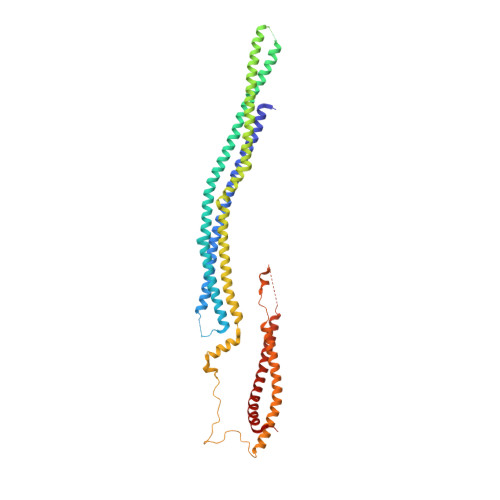Structural History of Human SRGAP2 Proteins.
Sporny, M., Guez-Haddad, J., Kreusch, A., Shakartzi, S., Neznansky, A., Cross, A., Isupov, M.N., Qualmann, B., Kessels, M.M., Opatowsky, Y.(2017) Mol Biol Evol 34: 1463-1478
- PubMed: 28333212
- DOI: https://doi.org/10.1093/molbev/msx094
- Primary Citation of Related Structures:
5I6J - PubMed Abstract:
In the development of the human brain, human-specific genes are considered to play key roles, conferring its unique advantages and vulnerabilities. At the time of Homo lineage divergence from Australopithecus, SRGAP2C gradually emerged through a process of serial duplications and mutagenesis from ancestral SRGAP2A (3.4-2.4 Ma). Remarkably, ectopic expression of SRGAP2C endows cultured mouse brain cells, with human-like characteristics, specifically, increased dendritic spine length and density. To understand the molecular mechanisms underlying this change in neuronal morphology, we determined the structure of SRGAP2A and studied the interplay between SRGAP2A and SRGAP2C. We found that: 1) SRGAP2A homo-dimerizes through a large interface that includes an F-BAR domain, a newly identified F-BAR extension (Fx), and RhoGAP-SH3 domains. 2) SRGAP2A has an unusual inverse geometry, enabling associations with lamellipodia and dendritic spine heads in vivo, and scaffolding of membrane protrusions in cell culture. 3) As a result of the initial partial duplication event (∼3.4 Ma), SRGAP2C carries a defective Fx-domain that severely compromises its solubility and membrane-scaffolding ability. Consistently, SRGAP2A:SRAGP2C hetero-dimers form, but are insoluble, inhibiting SRGAP2A activity. 4) Inactivation of SRGAP2A is sensitive to the level of hetero-dimerization with SRGAP2C. 5) The primal form of SRGAP2C (P-SRGAP2C, existing between ∼3.4 and 2.4 Ma) is less effective in hetero-dimerizing with SRGAP2A than the modern SRGAP2C, which carries several substitutions (from ∼2.4 Ma). Thus, the genetic mutagenesis phase contributed to modulation of SRGAP2A's inhibition of neuronal expansion, by introducing and improving the formation of inactive SRGAP2A:SRGAP2C hetero-dimers, indicating a stepwise involvement of SRGAP2C in human evolutionary history.
Organizational Affiliation:
The Mina & Everard Goodman Faculty of Life Sciences, Bar-Ilan University, Ramat Gan, Israel.














